TOHONO O’ODHAM NATION — In a vibrant building adorned with murals on the grounds of Tohono O’odham Community College, students gather in a classroom around a U-shaped table. Here, under the guidance of Marvin Carmen, the course instructor, they learn the fundamentals of email composition. With focused attention, they absorb Carmen’s instructions on writing recipients in the “To” section, crafting subjects for their messages and formatting mock emails for practice.
“It’s an electronic letter, that’s what an email is,” Carmen told the students before he taught them how to send an email.
This class is one of many programs in the Tohono O’odham Nation that benefit from the assistance of the Tohono O’odham Utility Authority, which recently received a $10 million grant from the U.S. Department of Agriculture to establish a fiber-optic network to implement and improve internet connectivity on the reservation.
“This will give the villages and the members of the nation the opportunity to have broadband services that they don’t have,” said Brian Fickett, the general manager of the utility authority.
Before the improved fiber optic network, Tonya Joaquin, a resident of Vaya Chin, a village in the Tohono O’odham Nation’s Hickiwan District, said she and her son had trouble connecting to the internet because their connection was very slow.
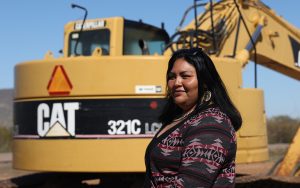
Vaya Chin resident Tonya Joaquin on Feb. 13 at the construction site that will bring faster internet to her home. (Photo by Crystal Aguilar/Cronkite News)
Joaquin said their internet connection was so slow she had to move her classes to the evening so her son could connect to the internet and do his schooling during the day.
“We are still able to watch our Netflix. We are still able to watch our Disney+. And, you know, we are still able to upload and download things. However, it is at a slower pace,” Joaquin said about the speed of their current internet connection.
Joaquin said the fiber-optic network will help her and her family because it will allow them to submit homework faster and watch their streaming services on multiple screens.
“As a whole, I believe that the new generation will have a great impact because they are more in tune with the new technology. But as for the older generation, I’m not sure how it will fit into their life as they prefer to do everything written by hand or do person-to-person,” Joaquin said.
Connecting to the digital world
Fickett said some people on the reservation still do not know what the internet is.
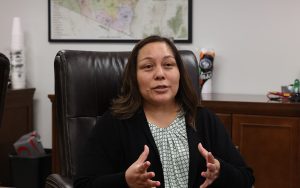
Kristan Johnson has been working at the Tohono O’odham Utility Authority for 23 years. “We’re able to educate and teach our tribalship of all ages and all backgrounds how to use it.” Johnson says this will help the community preserve its heritage and protect its language. (Photo by Crystal Aguilar/Cronkite News)
“I realized real quick is we had an issue where we got all this fiber, this really nice system we’re putting in the ground but the members and our customers don’t understand what they have and they don’t understand how to use that service,” Fickett said.
Kristan Johnson, the telephone operations manager at the Tohono O’odham Utility Authority, believes the reason the internet has taken so long to reach the nation’s elders is that English was not their first language.
“So being able to interpret a modern technology into a traditional language is a barrier and it’s scary,” Johnson said.
Johnson said that the fear is also attributed to the horror stories elders heard from people outside the authority about being watched.
Anselmo Ramon, chair of workforce and community development at the community college, said there is also a valid fear from community members who never had internet access that their identity and personal information is going to be stolen if they get on the internet. “There’s a hesitancy, especially in the older generations, not to want connectivity. They don’t want this service at home. They don’t want it, even if it’s paid for,” he said.
Johnson said it’s a slow process.
“We do educate them that while there’s crime here on Earth, there’s also virtual crimes and we just want to teach them how to be safe and how to maneuver, so it is going to take some time,” Johnson said.

A fiber-optic network construction site in Vaya Chin in the Tohono O’odham Nation on Feb. 13, part of a project that aims to give locals faster internet access in their homes. (Photo by Crystal Aguilar/Cronkite News)
Johnson said the authority also contacts every single village on the reservation to let them know that they are installing fiber optics.
“When we leave, we let them know that we’re willing to come back to the villages to teach them and put a tablet, computer, cell phone in front of them,” Johnson said.
Fickett said the authority has been working on a plan to educate tribal residents about the benefits of internet access.
One of the ways, Fickett said, is by setting up TVs and streaming services in their offices to show residents what kind of TVs they can buy if they get internet.
But Fickett said his team knew that was not going to be enough.
“One of the things that’s unique is here, we have elders that they don’t even know what internet is. So we have to basically go back and teach them what is the internet,” Fickett said.
In response, Fickett said the authority partnered with the community college to educate tribal members on the basics of using the internet.
How to send an email
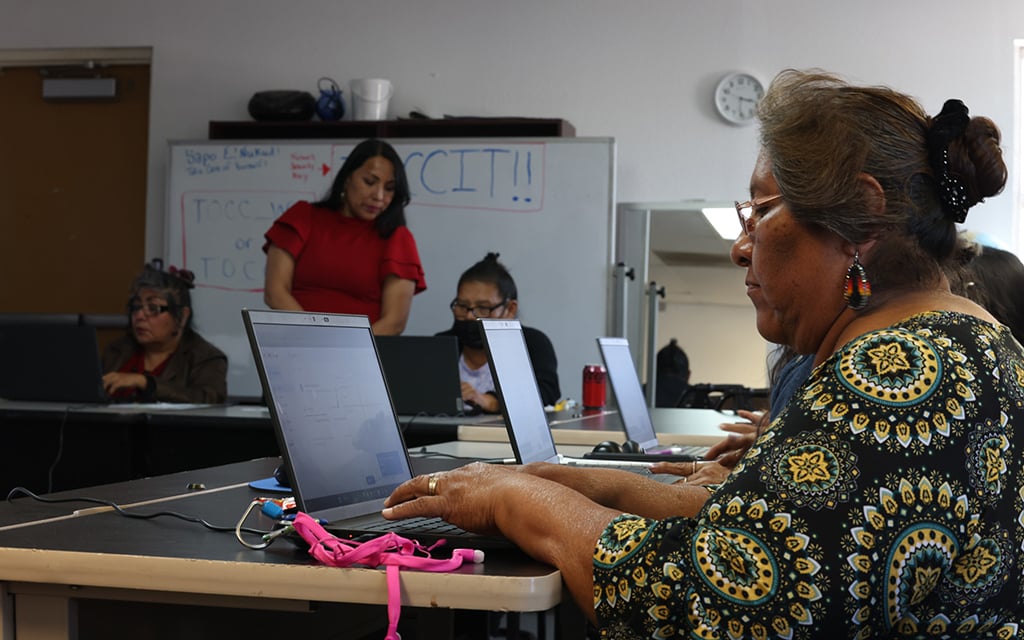
Florina Esteban learns how to set up and send emails at Tohono O’odham Community College on Feb. 13. There are multiple classes a day for those ready to take on new technology. (Photo by Crystal Aguilar/Cronkite News)
Ramon oversees the National Telecommunications and Information Administration grant-funded course that seeks to provide community members from each of the 11 districts in the Tohono O’odham Nation with internet literacy skills.
Before they teach people how to send emails, Ramon said the course at the community college teaches students basic computer skills, such as the components of a computer, how to turn on their devices and how to care for them.
Ramon said the course is informal because there is no final exam on which they are graded.
“It’s basically training,” Ramon said. Students track their progress through quizzes that help them move along through every section of the class.
With every passing quiz, Ramon said the students are excited to see their grades go up.
“They can see it themselves. They’re in charge of how far they’re going to go. And so for them to see their grades climbing from 70, I didn’t do so well, 60, now I’m at 80, so that motivates them, even at an older age. It really works. It helps them to build confidence in their abilities to learn the computer,” Ramon said.
Juanita Homer, 71, a student of the course, first started using computers when she was in her 50s. It was five years, however, before she took the course and she had never used a laptop.
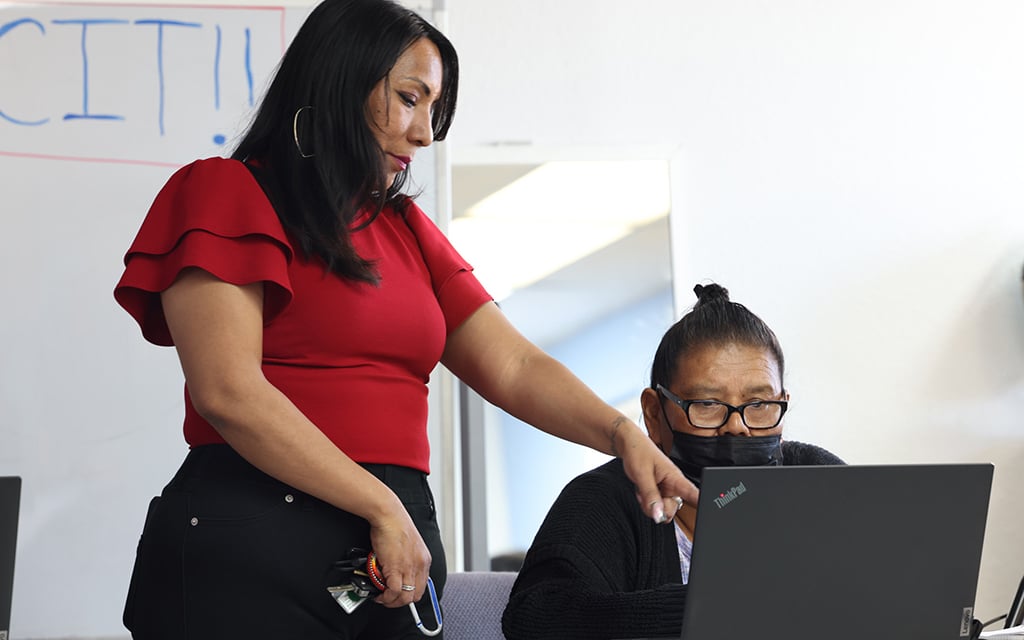
June Starr, left, helps Francine Jose operate her computer and guides her through Gmail on Feb. 13. Jose was part of a group of residents from Chukut Kut, a Tohono O’odham district on the U.S.-Mexico border. (Photo by Crystal Aguilar/Cronkite News)
“It’s helping me gain new knowledge. You’re never too old to learn. I feel like I’m learning every time I come,” Homer said.
Before the course, Francine Jose, 57, had never used a computer.
“It’s really new to me. Everything’s new to me,” Jose said.
Sometimes, Homer said she felt frustrated with the learning curve but the teachers helped them throughout the process.
Homer said it’s just a matter of practicing what they learned. Jose said the training is vital.
“I do want to do other stuff like schooling, and I know a lot of times it requires computers. And as the future’s going towards computers already, I’m already left behind but I’m hoping to get there soon,” Jose said.
Train the trainer
Ramon said the grant will assist community members like the students who traveled from Chukut Kuk, a Tohono O’odham district located near the U.S.-Mexico border by providing them internet connectivity they do not currently have.
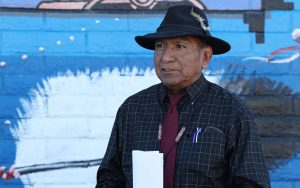
Anselmo Ramon, the chair of workforce and community development at the Tohono O’odham Community College , said computer training is vital. (Photo by Crystal Aguilar/Cronkite News)
Ramon said the course will give participants the skills to navigate the internet once it is set up in their homes by the utility authority.
Ramon said the long-term goal of the class is to “train the trainer.” They hope to train 10 people to use the internet who can then train a family member, friend or a coworker.
“The goal is to allow more people to become involved in computer literacy, understanding and training. We want that to grow within each district,” Ramon said.
Economic and cultural opportunity
Johnson said she hopes that the expansion of the fiber optic network and the internet literacy courses ultimately provide members of the Tohono O’odham Nation with an opportunity for economic development.
“Whether they’re basket weavers, they’re dressmakers, you know, they harvest or whatever they do, they’re able to put that on the internet and be able to sell it and … you know, help themselves out,” Johnson said.
In addition to the economic opportunities, Fickett and Johnson said they see this as an opportunity for Tohono O’odham members to preserve their culture and heritage.
“With the broadband services and the different services it offers, we’ll be able to help them get a YouTube channel going or getting some other service going where they can tell their story and be able to broadcast that story worldwide, where in the past it’s only been kept in a small group,” Fickett said.
Johnson and Ramon said language is another important aspect of Tohono O’odham culture that can be preserved through the internet.
According to the UNESCO World Atlas of Languages, the Tohono O’odham language is endangered.
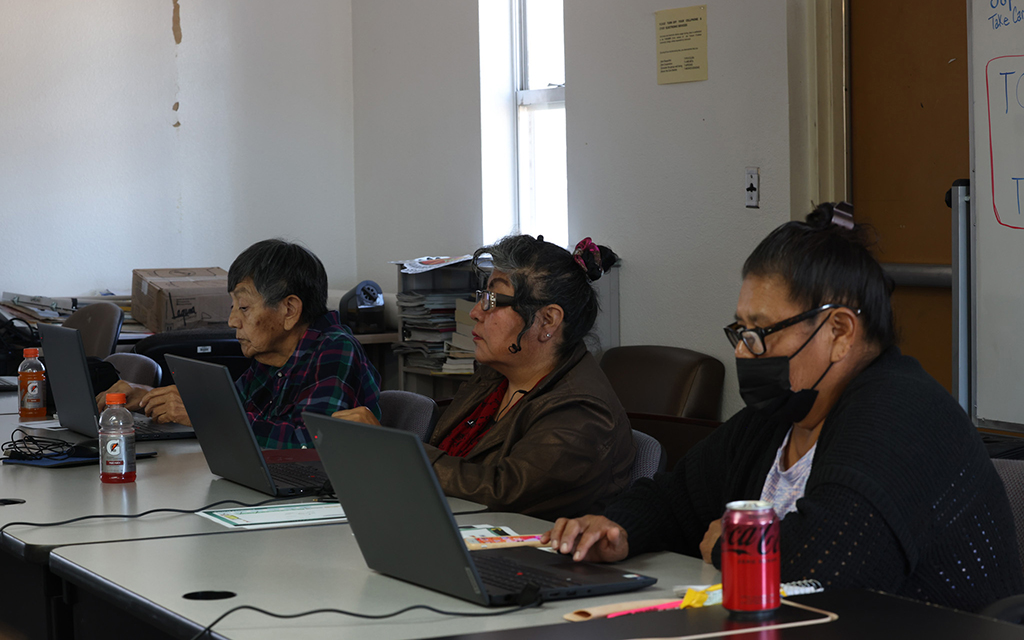
From left, Juanita Mattias, Elaine Johnson and Francine Jose in class on Feb. 13 on learning the basics of operating a laptop. (Photo by Crystal Aguilar/Cronkite News)
“So this provides another opportunity for people who have learned how to use the internet, how to connect via Zoom and how to start those conversations, start their own language groups,” Ramon said.
‘She heard I was taking computer classes’
The assignment for Jose and Homer’s class was to create and send an email about one thing they learned, one thing they wanted to learn and one thing that could help them remember.
The students went step by step through the process. They were taught to locate the waffle and Gmail icons, and afterward, they reviewed the keyboard for composing an email.
Homer said she wants other community members to join the class.
“In fact, yesterday, a lady said she heard I was taking computer classes. … She said, ‘I always wanted to learn,’ and I told her, ‘Yeah, the classes are going on,’” Homer said. Homer said the woman she spoke to is planning to call the community college about the class.


